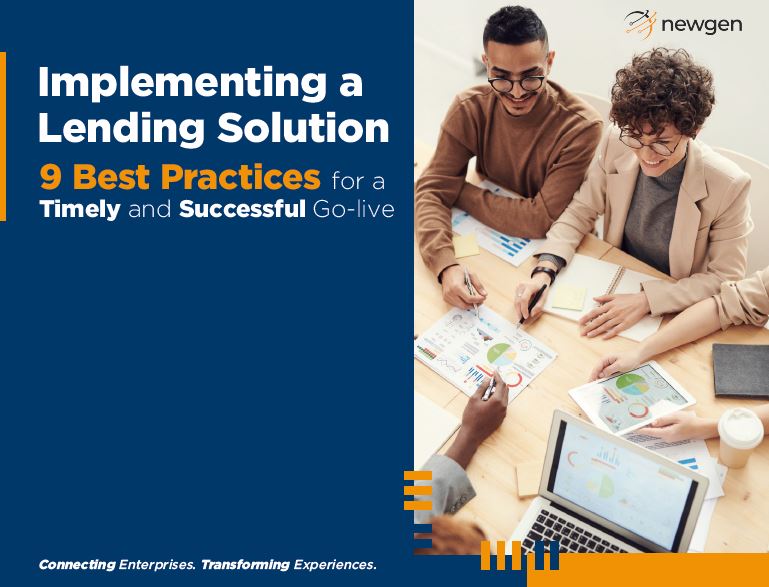Why Lending Transformation Matters?
The lending business is the growth engine of most banks and financial institutions. But implementing a modern lending platform is rarely straightforward. From outdated legacy systems to complex workflows and regulatory pressures, many digital transformation projects run over time, over budget, and under deliver.
This eBook provides practical guidance and proven best practices to ensure your lending technology initiative goes live on time, stays on budget, and creates measurable impact.
The Core Challenge
Banks know they must modernize to compete with digital-first lenders, but common hurdles include:
- Complex legacy ecosystems — multiple disjointed systems for origination, underwriting, documentation, and servicing
- Slow implementation cycles — delays caused by unclear scope, scope creep, or poor planning
- High performance and compliance risk — difficulty aligning technology with business expectations and regulatory standards
- Manual workarounds — leading to inefficiencies, errors, and longer loan turnaround times
These challenges can turn a promising initiative into a drawn-out, expensive effort that fails to deliver expected ROI.
Newgen’s Proven Approach to Lending Transformation
Newgen helps financial institutions overcome these challenges through a low-code, AI-first digital automation platform and a mature implementation methodology designed for speed, agility, and risk reduction.
Low-Code Digital Automation Platform
Banks need flexibility without losing control. Newgen’s platform lets teams:
- Build connected, adaptive, and future-ready loan processes
- Quickly create and update applications without heavy coding
- Streamline operations and reduce dependency on IT
- Engage customers across channels while staying compliant
It brings together three key capabilities:
- Intelligent Process Automation (BPM) — digitizing and orchestrating complex workflows
- Contextual Content Services (ECM) — centralizing and managing loan-related data and documents
- Omnichannel Customer Engagement (CCM) — delivering a consistent borrower experience
Agile Implementation Methodology: Four Steps to Success
A sprint-based approach keeps the project fast and flexible while ensuring quality:
- Discover & Define
Understand business needs, gather requirements, and create a clear base process model. - Design & Build
Develop the lending application in iterations, review with stakeholders, and adjust early to avoid rework. - Test & Validate
Refine and enhance the application while adhering to IT guardrails. Conduct user acceptance testing for accuracy and readiness. - Deploy & Go-Live
Configure for production, finalize sign-offs, and transition to live operations with minimal disruption.
Nine Best Practices to De-Risk Lending Transformation
Newgen has distilled key learnings from numerous global implementations to help financial institutions avoid pitfalls:
- Control Scope and Prevent Scope Creep
Finalize and sign off the Scope of Work (SOW) early. Any new requirements go through formal change management to avoid delays. - Adopt a Partnership-Based Model
Collaborate with local partners and system integrators trained in Newgen’s platform for seamless deployment and faster adoption. - Leverage Domain Expertise
Use experienced banking SMEs, business analysts, and solution architects to align technology with lending best practices and regulatory needs. - Prioritize Training and Knowledge Transfer
Equip your teams with deep training to ensure long-term self-sufficiency and faster adoption. - Use Ready-made Adapters for Faster Integration
Pre-built connectors simplify linking with core banking systems, CRMs, credit bureaus, payment gateways, and regulatory checks. - Apply Process Re-engineering
Streamline and optimize lending workflows before automating — don’t just digitize inefficiencies. - Balance Customization and Out-of-the-Box Functionality
Avoid over-customization that slows projects and complicates upgrades; use flexible low-code frameworks for scalability. - Enable Analytics-Driven Decision Making
Use real-time data insights to improve risk evaluation, monitor SLAs, and accelerate decisioning. - Implement Strong Project Governance
Track milestones, risks, and dependencies proactively to keep the initiative aligned and on time.
Measurable Impact of Successful Implementation
Banks that adopt this structured, low-code-driven approach have achieved:
- 50% reduction in operational costs
- 75% improvement in tracking and monitoring of loan processes
- 80% faster turnaround time
- 90–95% better first-time-right rates
- 99% compliance accuracy
These outcomes mean faster credit decisions, stronger risk management, improved borrower experience, and measurable ROI.
Future-Ready Lending: Built for Change
Beyond immediate process improvement, this approach future-proofs lending with advanced capabilities:
- AI/ML models for intelligent risk scoring and fraud detection
- Blockchain for secure document exchange and digital signatures
- APIs & Open Banking integrations for partner ecosystems
- Robotic Process Automation (RPA) for routine task automation
- Mobile-first and omnichannel borrower engagement
This flexibility lets banks adapt quickly to new lending models, regulations, and customer expectations.
Why Partner With Newgen?
Newgen brings decades of experience in digital banking transformation, trusted by leading global banks. Its platform + methodology combination helps institutions:
- Modernize at their own pace without ripping and replacing legacy systems
- Achieve faster go-live and adoption with lower project risk
- Keep compliance and security embedded in every step
- Enable continuous innovation with low-code agility
Take the Next Step
If your institution is planning or struggling with a lending platform implementation, Newgen can help you achieve a smooth, timely go-live and a future-proof lending ecosystem.

